Page Number: 168
Question 1
Define the principal focus of a concave mirror.
Answer:
The principal focus of a concave mirror is a point on its principal axis to which all the light rays which are parallel and close to the axis, converge after reflection from the concave mirror.
Question 2
The radius of curvature of a spherical mirror is 20 cm. What is its focal length?
Answer:
Focal length = 1/2 x Radius of curvature = 1/2 x 20 cm = 10 cm
Question 3
Name a mirror that can give an erect and enlarged image of an object.
Answer:
Concave mirror.
Question 4
Why do we prefer a convex mirror as a rear-view mirror in vehicles ?
Answer:
We prefer a convex mirror as a rear-view mirror in vehicles because of two reasons :
- A convex mirror always produces an erect image of the objects.
- The image formed in a convex mirror is highly diminished or much smaller than the object, due to which a convex mirror gives a wide field of view of the traffic behind. A convex mirror enables the driver to view such larger area of the traffic behind him.
Page Number: 171
Question 1
Find the focal length of a convex mirror whose radius of curvature is 32 cm.
Solution:
R = +32 cm and ![]()
Question 2
A concave mirror produces three times magnified (enlarged) real image of an object placed at 10 cm in front of it. Where is the image located ?
Solution:
Because the image is real, so magnification m must be negative.

Thus the image is located at a distance of 30 cm from the mirror on the object side of the mirror.
Page Number: 176
Question 1
A ray of light travelling in air enters obliquely into water. Does the light ray bend towards the normal or away from the normal ? Why ?
Answer:
The light-ray bends towards the normal because the ray of light goes from a rarer medium to a denser medium.
Question 2
Light enters from air to glass having refractive index 1.50. What is the speed of light in the glass ? The speed of light in vacuum is 3 x 108 ms-1.
Solution:
Refractive index of glass, n8 = 1.50

Question 3
Find out, from Table 10.3, the medium having highest optical density. Also find the medium with lowest optical density.
Answer:
From table 10.3, diamond has highest refractive index (= 2.42), so it has highest optical density.
Air has lowest refractive index (= 1.0003),
so it has lowest optical density.
Question 4
You are given kerosene, turpentine and water. In which of these does the light travel fastest ? Use the information given in Table 10.3.
Answer:
For kerosene, n = 1.44
For turpentine, n = 1.47
For water, n = 1.33
Because water has the lowest refractive index, therefore light travels fastest in this optically rarer medium than kerosene and turpentine oil.
Question 5
The refractive index of diamond is 2.42. What is the meaning of this statement?
Answer:
By saying that the refractive index of diamond is 2.42, we mean that the speed of light in diamond is lower by a factor of 2.42 relative to that in vacuum.
Page Number: 184
Question 1
Define 1 dioptre of power of a lens.
Answer:
One dioptre is the power of a lens whose focal length is 1 metre.
Question 2
A convex lens forms a real and inverted image of a needle at a distance of 50 cm from it. Where is the needle placed in front of the convex lens if the image is equal to the size of the object ? Also, find the power of the lens. , Sol. Here, u — +50 cm ..
Solution:
Here ν = +50cm
Because the real image is of the same size as the object,
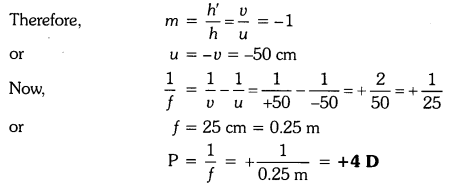
Question 3
Find the power of a concave lens of focal length 2 m.
Solution:
Because the focal length of a concave lens is negative,
therefore f = -2 m

Exercise : Text Book
1. Which one of the following materials cannot be used to make a lens?
(a) Water
(b) Glass
(c) Plastic
(d) Clay
Answer –
(d) Clay cannot be used to make a lens because if the lens is made up of clay the light rays cannot pass through it
2. The image formed by a concave mirror is observed to be virtual, erect and larger than the object. Where should be the position of the object?
(a) Between the principal focus and the centre of curvature
(b) At the centre of curvature
(c) Beyond the centre of curvature
(d) Between the pole of the mirror and its principal focus.
Answer-
(d) The position of the object should be between the pole of the mirror and its principal focus.
3. Where should an object be placed in front of a convex lens to get a real image of the size of the object?
(a) At the principal focus of the lens
(b) At twice the focal length
(c) At infinity
(d) Between the optical centre of the lens and its principal focus.
Answer –
(b) The object should be placed at twice the focal length
4. A spherical mirror and a thin spherical lens have a focal length of -15 cm. The mirror and the lens are likely to be
(a) both concave
(b) both convex
(c) the mirror is concave and the lens is convex
(d) the mirror is convex, but the lens is concave
Answer –
(a) Both are likely to be concave.
Page No: 186
5. No matter how far you stand from a mirror, your image appears erect. The mirror is likely to be
(a) plane
(b) concave
(c) convex
(d) either plane or convex
Answer –
(d) The mirrors are likely to be either plane or convex
6. Which of the following lenses would you prefer to use while reading small letters found in a dictionary?
(a) A convex lens of focal length 50 cm
(b) A concave lens of focal length 50 cm
(c) A convex lens of focal length 5 cm
(d) A concave lens of focal length 5 cm
Answer –
(c) A convex lens of focal length 5 cm can be used while reading small letters found in a dictionary
7. We wish to obtain an erect image of an object, using a concave mirror of focal length 15 cm. What should be the range of distance of the object from the mirror? What is the nature of the image? Is the image larger or smaller than the object? Draw a ray diagram to show the image formation in this case.
Answer-
Range of the distance of the object = 0 to 15 cm from the pole of the mirror.
Nature of the image = virtual, erect, and larger than the object.
8. Name the type of mirror used in the following situations.
(a) Headlights of a car
(b) Side/rear-view mirror of a vehicle
(c) Solar furnace
Support your answer with reason.
Answer-
(a) Concave Mirror: Because concave mirrors can produce a powerful parallel beam of light when the light source is placed at their principal focus.
(b) Convex Mirror: Because of its largest field of view.
(c) Concave Mirror: Because it concentrates the parallel rays of the sun at a principal focus.
9. One-half of a convex lens is covered with a black paper. Will this lens produce a complete image of the object? Verify your answer experimentally. Explain your observations.
Answer-
Yes, it will produce a complete image of the object, as shown in the figure. This can be verified experimentally by observing the image of a distant object like a tree on a screen when the lower half of the lens is covered with a black paper. However, the intensity or brightness of the image will reduce.
10. An object 5 cm in length is held 25 cm away from a converging lens of focal length 10 cm. Draw the ray diagram and find the position, size and the nature of the image formed.
Answer-
Height of the Object, h0 = 5 cm
Distance of the object from converging lens, u = -25 cm
Focal length of a converging lens, f = 10 cm
Using lens formula,
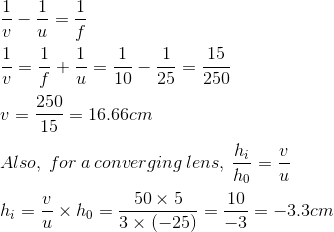
Thus, the image is inverted and formed at a distance of 16.7 cm behind the lens and measures 3.3 cm. The ray diagram is shown below.

11. A concave lens of focal length 15 cm forms an image 10 cm from the lens. How far is the object placed from the lens? Draw the ray diagram.
Answer-
Focal length of concave lens (OF1), f = – 15 cm
Image distance, v= – 10 cm
According to the lens formula,
The negative value of u indicates that the object is placed 30 cm in front of the lens. This is shown in the following ray diagram.

Object distance, u = -30 cm
The negative value of u indicates that the object is placed in front of the lens.
12. An object is placed at a distance of 10 cm from a convex mirror of focal length 15 cm. Find the position and nature of the image.
Answer-
Focal length of convex mirror (f) = +15 cm
Object distance (u) = – 10 cm
According to the mirror formula,
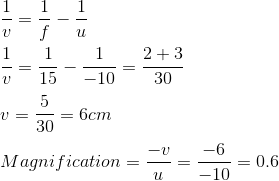
The image is located at a distance of 6 cm from the mirror on the other side of the mirror.
The positive and a value of less than 1 of magnification indicates that the image formed is virtual and erect and diminished.
13. The magnification produced by a plane mirror is +1. What does this mean?
Answer-
The positive sign means an image formed by a plane mirror is virtual and erect. Since the magnification is 1 it means that the size of the image is equal to the size of the object.
14. An object 5 cm is placed at a distance of 20 cm in front of a convex mirror of radius of curvature 30 cm. Find the position, nature and size of the image.
Answer-
Object distance (u) = – 20 cm
Object height (h) = 5 cm
Radius of curvature (R) = 30 cm
Radius of curvature = 2 × Focal length
R = 2f
f = 15 cm
According to the mirror formula,
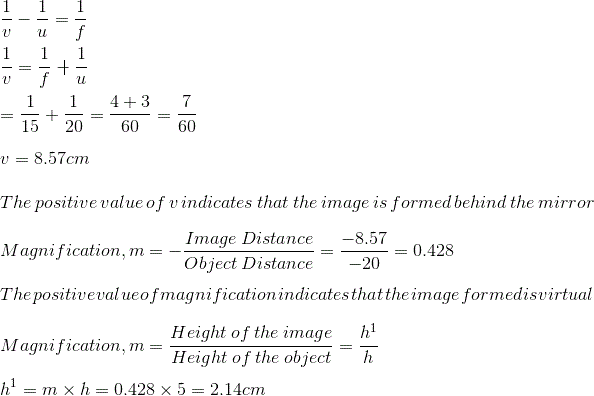
The positive value of image height indicates that the image formed is erect.
Hence, the image formed is erect, virtual, and smaller in size.
15. An object of size 7.0 cm is placed at 27 cm in front of a concave mirror of focal length 18 cm. At what distance from the mirror should a screen be placed so that a sharply focused image can be obtained? Find the size and nature of the image.
Answer-
Object distance (u) = – 27 cm
Object height (h) = 7 cm
Focal length (f) = – 18 cm
According to the mirror formula,
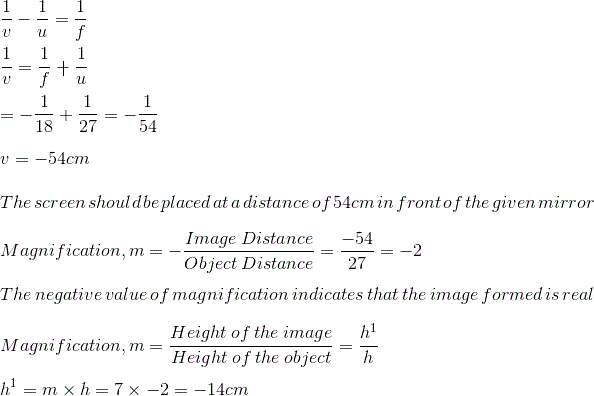
The negative value of image height indicates that the image formed is inverted.
16. Find the focal length of a lens of power -2.0 D. What type of lens is this?
Answer-
Power of lens (P) = 1/f
P = -2D
f = -1/2 = -0.5 m
A concave lens has a negative focal length. Therefore, it is a concave lens.
17. A doctor has prescribed a corrective lens of power +1.5 D. Find the focal length of the lens. Is the prescribed lens diverging or converging?
Answer-
Power of lens (P) = 1/f
P = 1.5D
f = 1/1.5 = 10/15 = 0.66 m
A convex lens has a positive focal length. Therefore, it is a convex lens or a converging lens.


